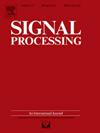Phase differences estimation for diagonal ULAs within a fully filled rectangular array based on degenerated spatial ARMA process
IF 3.4
2区 工程技术
Q2 ENGINEERING, ELECTRICAL & ELECTRONIC
引用次数: 0
Abstract
A generalized estimation method of diagonal phase differences of external sources incident upon a fully-filled rectangular array (FFRA) is proposed based on degenerate spatial ARMA process. Various diagonal uniform linear arrays (ULAs) within FFRAs are first classified by function forms of diagonal phase differences, the ULAs sharing the same diagonal phase difference belong to one category. The modified Yule–Walker (MYW) system of linear equations and the root-finding polynomial are first derived for FFRA ULAs. Owing to diagonal interspacings larger than half of carrier wavelength, ambiguity problem of diagonal phase differences has arisen in estimation. Utilizing the explicit linear-combination relationships satisfied by diagonal and axial phase differences, a simple and effective elimination scheme of estimate ambiguity of diagonal phase differences is proposed in which actual intervals of no ambiguity are deduced by making use of the estimates of axial phase differences. With different FFRA diagonal ULAs on sensor plane, it is numerically manifested by Monte-Carlo trials that the proposed method is effective for both independent and coherent sources and the Root mean square errors (RMSEs) are slowly convergent to the corresponding Cramer–Rao bounds (CRBs) after estimate ambiguities are eliminated. The consistency of estimation performance for diagonal ULAs belonging to one category is exhibited by their identical RMSEs. Because of the ability to exploit axial and diagonal ULAs, the proposed estimation method provides the basis of two-dimensional direction of arrival (2-D DoA) estimation with ULA combinations of FFRAs.
基于退化空间ARMA过程的全填充矩形阵列对角线ula相位差估计
提出了一种基于退化空间ARMA过程的全填充矩形阵列入射外源对角相位差的广义估计方法。首先根据对角相位差的函数形式对ffra内的各种对角均匀线性阵列进行分类,具有相同对角相位差的ula属于一类。首先导出了FFRA ula的修正Yule-Walker (MYW)线性方程组和寻根多项式。由于对角线间距大于载波波长的一半,在估计中产生了对角线相位差的模糊问题。利用对角线相位差和轴向相位差所满足的显式线性组合关系,提出了一种简单有效的对角线相位差模糊估计消除方案,利用轴向相位差估计推导出无模糊的实际区间。在X−Y传感器平面上使用不同的FFRA对角ULAs,通过Monte-Carlo试验数值验证了该方法对独立源和相干源都是有效的,并且在消除估计歧义后,均方根误差(rmse)缓慢收敛到相应的Cramer-Rao界(crb)。同一类对角ULAs的估计性能一致性表现为它们的均方根值相同。由于能够利用轴向和对角线ULA,该估计方法为利用ffra的ULA组合进行二维到达方向(2-D DoA)估计提供了基础。
本文章由计算机程序翻译,如有差异,请以英文原文为准。
求助全文
约1分钟内获得全文
求助全文
来源期刊

Signal Processing
工程技术-工程:电子与电气
CiteScore
9.20
自引率
9.10%
发文量
309
审稿时长
41 days
期刊介绍:
Signal Processing incorporates all aspects of the theory and practice of signal processing. It features original research work, tutorial and review articles, and accounts of practical developments. It is intended for a rapid dissemination of knowledge and experience to engineers and scientists working in the research, development or practical application of signal processing.
Subject areas covered by the journal include: Signal Theory; Stochastic Processes; Detection and Estimation; Spectral Analysis; Filtering; Signal Processing Systems; Software Developments; Image Processing; Pattern Recognition; Optical Signal Processing; Digital Signal Processing; Multi-dimensional Signal Processing; Communication Signal Processing; Biomedical Signal Processing; Geophysical and Astrophysical Signal Processing; Earth Resources Signal Processing; Acoustic and Vibration Signal Processing; Data Processing; Remote Sensing; Signal Processing Technology; Radar Signal Processing; Sonar Signal Processing; Industrial Applications; New Applications.
 求助内容:
求助内容: 应助结果提醒方式:
应助结果提醒方式:


